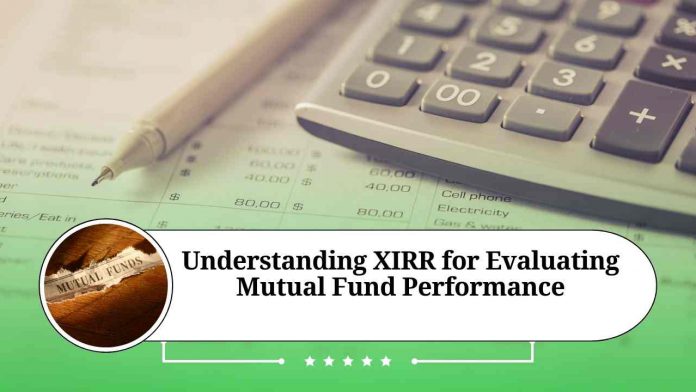Mutual funds are an increasingly popular investment option for those looking to grow their wealth over time. One of the key factors that investors consider when choosing a mutual fund is its performance. This is where XIRR comes into play. In this blog, we’ll take a closer look at what XIRR is, how it is calculated, and why it is an important metric to consider when evaluating mutual fund performance.
What is XIRR?
XIRR stands for Extended Internal Rate of Return. It is a financial metric used to calculate the rate of return for an investment over a period of time, taking into account the timing and amount of each cash flow. The XIRR method is commonly used in mutual fund investments, especially in cases where investors have made multiple investments or withdrawals at different times.
How is XIRR calculated?
To calculate XIRR, we need to know the cash inflows and outflows from an investment. In the case of mutual funds, these cash flows can be in the form of investments made at different times, as well as any redemptions or dividends received.
To calculate XIRR, we first need to input the cash flows and their respective dates into a spreadsheet. We then use the XIRR function in the spreadsheet to calculate the rate of return. The XIRR function takes into account the dates and amounts of each cash flow, as well as the initial investment and final value of the investment.
Why is XIRR important for evaluating mutual fund performance?
XIRR is an important metric for evaluating mutual fund performance because it takes into account the timing and amount of each cash flow, providing a more accurate picture of the investment’s performance over time. This is especially important for mutual fund investments, which are typically made over a period of time with multiple transactions.
For example, let’s say an investor made a series of investments in a mutual fund over a period of three years, and then redeemed their investment after five years. The XIRR calculation would take into account each investment and its respective date, as well as the redemption amount and date. This would provide a more accurate representation of the investment’s overall performance than simply looking at the return over the five-year period.
Another benefit of XIRR is that it can help investors to understand the impact of fees and expenses on their investment returns. Mutual funds often charge fees such as management fees, administrative expenses, and other costs, which can eat into an investor’s returns. By calculating the XIRR, investors can see the actual return on their investment, after accounting for these fees and expenses.
However, it’s important to note that XIRR is just one metric to consider when evaluating mutual fund performance. Investors should also consider other factors, such as the fund’s investment strategy, risk profile, and past performance. It’s important to conduct thorough research and due diligence before investing in any mutual fund.
Conclusion
In conclusion, XIRR is a powerful tool for evaluating mutual fund performance. By taking into account the timing and amount of each cash flow, XIRR provides a more accurate picture of an investment’s performance over time. This can help investors make informed decisions about which mutual funds to invest in, and can also help them to understand the impact of fees and expenses on their investment returns. While XIRR is an important metric to consider, it’s important to also consider other factors when evaluating mutual fund investments.
Other Related Blogs: Section 144B Income Tax Act
Frequently Asked Questions (FAQs)
Q: What is XIRR?
A: XIRR stands for Extended Internal Rate of Return. It is a financial metric used to calculate the rate of return for an investment over a period of time, taking into account the timing and amount of each cash flow.
Q: How is XIRR calculated?
A: To calculate XIRR, you need to input the cash flows and their respective dates into a spreadsheet. You can then use the XIRR function in the spreadsheet to calculate the rate of return. The XIRR function takes into account the dates and amounts of each cash flow, as well as the initial investment and final value of the investment.
Q: Why is XIRR important for evaluating mutual fund performance?
A: XIRR is important for evaluating mutual fund performance because it takes into account the timing and amount of each cash flow, providing a more accurate picture of the investment’s performance over time. This is especially important for mutual fund investments, which are typically made over a period of time with multiple transactions.
Q: Can XIRR be used to compare the performance of different mutual funds?
A: Yes, XIRR can be used to compare the performance of different mutual funds. By calculating the XIRR for multiple funds over the same period of time, investors can compare the rate of return for each investment and choose the one that performed the best.
Q: What other factors should I consider when evaluating mutual fund investments?
A: In addition to XIRR, investors should also consider other factors such as the fund’s investment strategy, risk profile, past performance, fees and expenses, and the overall economic and market conditions.
Q: Where can I find the XIRR for a mutual fund investment?
A: The XIRR for a mutual fund investment can usually be found in the fund’s performance report or fact sheet. You can also calculate it yourself using a spreadsheet or financial calculator.
Q: Is XIRR the only metric I should consider when evaluating mutual fund performance?
A: No, XIRR is just one metric to consider when evaluating mutual fund performance. It’s important to consider other factors as well, such as the fund’s investment strategy, risk profile, past performance, fees and expenses, and market conditions.




















